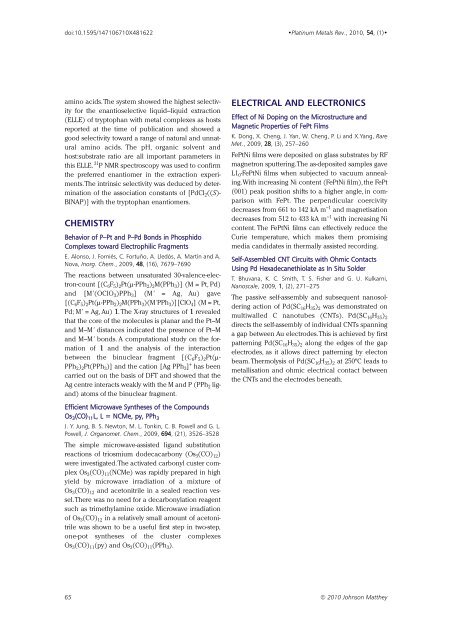Download Issue PDF - Platinum Metals Review
Download Issue PDF - Platinum Metals Review
Download Issue PDF - Platinum Metals Review
Create successful ePaper yourself
Turn your PDF publications into a flip-book with our unique Google optimized e-Paper software.
doi:10.1595/147106710X481622<br />
•<strong>Platinum</strong> <strong>Metals</strong> Rev., 2010, 54, (1)•<br />
amino acids.The system showed the highest selectivity<br />
for the enantioselective liquid–liquid extraction<br />
(ELLE) of tryptophan with metal complexes as hosts<br />
reported at the time of publication and showed a<br />
good selectivity toward a range of natural and unnatural<br />
amino acids. The pH, organic solvent and<br />
host:substrate ratio are all important parameters in<br />
this ELLE. 31 P NMR spectroscopy was used to confirm<br />
the preferred enantiomer in the extraction experiments.The<br />
intrinsic selectivity was deduced by determination<br />
of the association constants of [PdCl 2 ((S)-<br />
BINAP)] with the tryptophan enantiomers.<br />
CHEMISTRY<br />
Behavior of P–Pt and P–Pd Bonds in Phosphido<br />
Complexes toward Electrophilic Fragments<br />
E. Alonso, J. Forniés, C. Fortuño, A. Lledós, A. Martín and A.<br />
Nova, Inorg. Chem., 2009, 48, (16), 7679–7690<br />
The reactions between unsaturated 30-valence-electron-count<br />
[(C 6 F 5 ) 2 Pt(μ-PPh 2 ) 2 M(PPh 3 )] (M = Pt, Pd)<br />
and [M'(OClO 3 )PPh 3 ] (M' = Ag, Au) gave<br />
[(C 6 F 5 ) 2 Pt(μ-PPh 2 ) 2 M(PPh 3 )(M'PPh 3 )][ClO 4 ] (M = Pt,<br />
Pd; M' = Ag, Au) 1. The X-ray structures of 1 revealed<br />
that the core of the molecules is planar and the Pt–M<br />
and M–M' distances indicated the presence of Pt–M<br />
and M–M' bonds. A computational study on the formation<br />
of 1 and the analysis of the interaction<br />
between the binuclear fragment [(C 6 F 5 ) 2 Pt(μ-<br />
PPh 2 ) 2 Pt(PPh 3 )] and the cation [Ag PPh 3 ] + has been<br />
carried out on the basis of DFT and showed that the<br />
Ag centre interacts weakly with the M and P (PPh 2 ligand)<br />
atoms of the binuclear fragment.<br />
Efficient Microwave Syntheses of the Compounds<br />
Os 3 (CO) 11 L, L = NCMe, py, PPh 3<br />
J. Y. Jung, B. S. Newton, M. L. Tonkin, C. B. Powell and G. L.<br />
Powell, J. Organomet. Chem., 2009, 694, (21), 3526–3528<br />
The simple microwave-assisted ligand substitution<br />
reactions of triosmium dodecacarbony (Os 3 (CO) 12 )<br />
were investigated.The activated carbonyl custer complex<br />
Os 3 (CO) 11 (NCMe) was rapidly prepared in high<br />
yield by microwave irradiation of a mixture of<br />
Os 3 (CO) 12 and acetonitrile in a sealed reaction vessel.There<br />
was no need for a decarbonylation reagent<br />
such as trimethylamine oxide. Microwave irradiation<br />
of Os 3 (CO) 12 in a relatively small amount of acetonitrile<br />
was shown to be a useful first step in two-step,<br />
one-pot syntheses of the cluster complexes<br />
Os 3 (CO) 11 (py) and Os 3 (CO) 11 (PPh 3 ).<br />
ELECTRICAL AND ELECTRONICS<br />
Effect of Ni Doping on the Microstructure and<br />
Magnetic Properties of FePt Films<br />
K. Dong, X. Cheng, J. Yan, W. Cheng, P. Li and X.Yang, Rare<br />
Met., 2009, 28, (3), 257–260<br />
FePtNi films were deposited on glass substrates by RF<br />
magnetron sputtering.The as-deposited samples gave<br />
L1 0 -FePtNi films when subjected to vacuum annealing.With<br />
increasing Ni content (FePtNi film), the FePt<br />
(001) peak position shifts to a higher angle, in comparison<br />
with FePt. The perpendicular coercivity<br />
decreases from 661 to 142 kA m –1 and magnetisation<br />
decreases from 512 to 433 kA m –1 with increasing Ni<br />
content. The FePtNi films can effectively reduce the<br />
Curie temperature, which makes them promising<br />
media candidates in thermally assisted recording.<br />
Self-Assembled CNT Circuits with Ohmic Contacts<br />
Using Pd Hexadecanethiolate as In Situ Solder<br />
T. Bhuvana, K. C. Smith, T. S. Fisher and G. U. Kulkarni,<br />
Nanoscale, 2009, 1, (2), 271–275<br />
The passive self-assembly and subsequent nanosoldering<br />
action of Pd(SC 16 H 35 ) 2 was demonstrated on<br />
multiwalled C nanotubes (CNTs). Pd(SC 16 H 35 ) 2<br />
directs the self-assembly of individual CNTs spanning<br />
a gap between Au electrodes.This is achieved by first<br />
patterning Pd(SC 16 H 35 ) 2 along the edges of the gap<br />
electrodes, as it allows direct patterning by electon<br />
beam. Thermolysis of Pd(SC 16 H 35 ) 2 at 250ºC leads to<br />
metallisation and ohmic electrical contact between<br />
the CNTs and the electrodes beneath.<br />
65 © 2010 Johnson Matthey
















